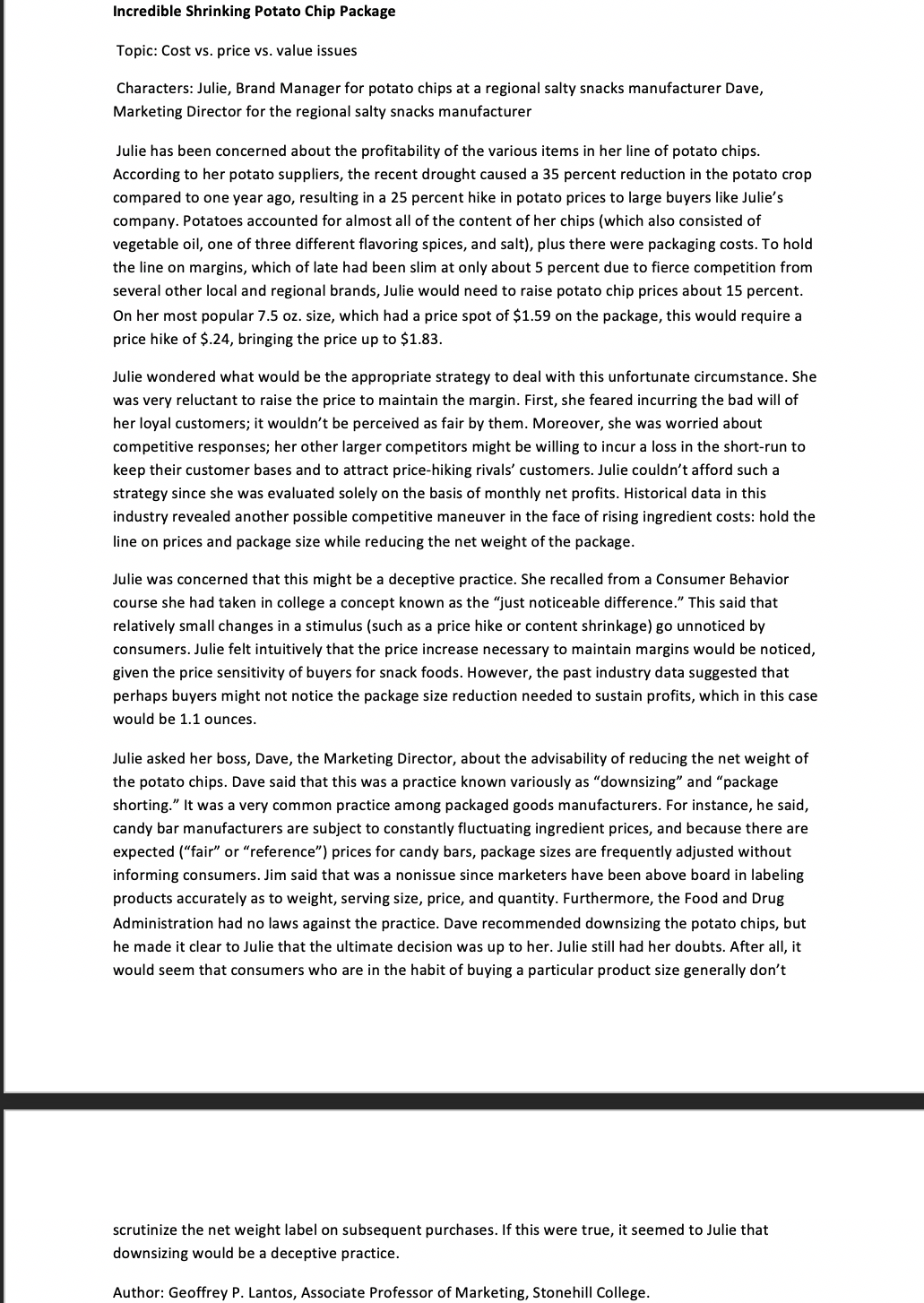What are the possible alternatives?
Incredible Shrinking Potato Chip Package Topic: Cost vs. price vs. value issues Characters: Julie, Brand Manager for potato chips at a regional salty snacks manufacturer Dave, Marketing Director for the regional salty snacks manufacturer Julie has been concerned about the profitability ofthe various items in her line of potato chips. According to her potato suppliers, the recent drought caused a 35 percent reduction in the potato crop compared to one year ago, resulting in a 25 percent hike in potato prices to large buyers like Julie's company. Potatoes accounted for almost all of the content of her chips (which also consisted of vegetable oil, one of three different avoring spices, and salt}, plus there were packaging costs. To hold the line on margins, which of late had been slim at only about 5 percent due to erce competition from several other local and regional brands, Julie would need to raise potato chip prices about 15 percent. On her most popular 7.5 oz. size, which had a price spot of $1.59 on the package, this would require a price hike of $.24, bringing the price up to $1.83. Julie wondered what would be the appropriate strategy to deal with this unfortunate circumstance. She was very reluctant to raise the price to maintain the margin. First, she feared incurring the bad will of her loyal customers; it wouldn't be perceived as fair by them. Moreover, she was worried about competitive responses; her other larger competitors might be willing to incur a loss in the short~run to keep their customer bases and to attract priceuhiking rivals' customers. Julie couldn't afford such a strategy since she was evaluated solely on the basis of monthly net prots. Historical data in this industry revealed another possible competitive maneuver in the face of rising ingredient costs: hold the line on prices and package size while reducing the net weight ofthe package. Julie was concerned that this might be a deceptive practice. She recalled from a Consumer Behavior course she had taken in college a concept known as the "just noticeable difference.\" This said that relatively small changes in a stimulus (such as a price hike or content shrinkage) go unnoticed by consumers. Julie felt intuitively that the price increase necessary to maintain margins would be noticed, given the price sensitivity of buyers for snack foods. However, the past industry data suggested that perhaps buyers might not notice the package size reduction needed to sustain prots, which in this case would be 1.1 ounces. Julie asked her boss, Dave, the Marketing Director, about the advisability of reducing the net weight of the potato chips. Dave said that this was a practice known variously as \"downsizing" and \"package shorting.\" It was a very common practice among packaged goods manufacturers. For instance, he said, candy bar manufacturers are subject to constantly fluctuating ingredient prices, and because there are expected {\"fair" or \"reference\"} prices for candy bars, package sizes are frequently adjusted without informing consumers. Jim said that was a nonissue since marketers have been above board in labeling products accurately as to weight, serving size, price, and quantity. Furthermore, the Food and Drug Administration had no laws against the practice. Dave recommended downsizing the potato chips, but he made it clear to Julie that the ultimate decision was up to her. Julie still had her doubts. After all, it would seem that consumers who are in the habit of buying a particular product size generally don't scrutinize the net weight label on subsequent purchases. If this were true, it seemed to Julie that downsizing would be a deceptive practice. Author: Geoffrey P. Lantos, Associate Professor of Marketing, Stonehill College







